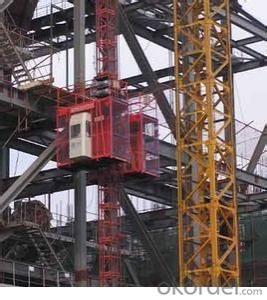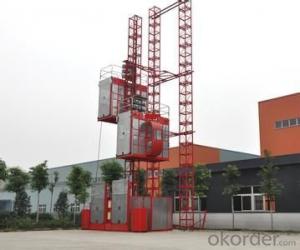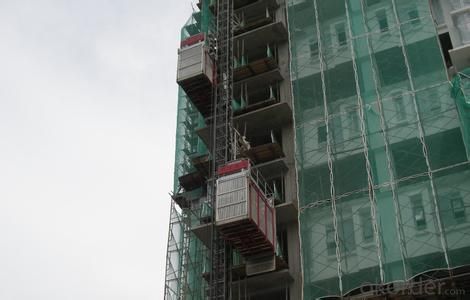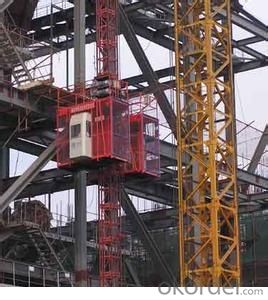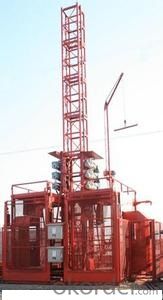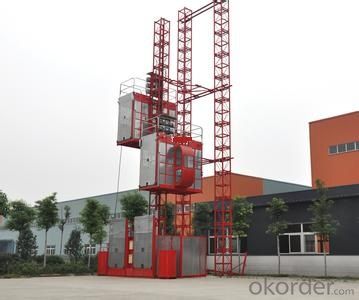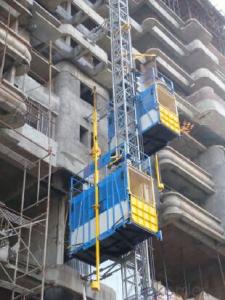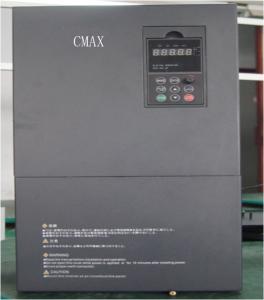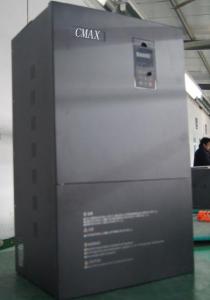Elevator Three-Drive 650 Frequency Conversion
- Loading Port:
- Qingdao
- Payment Terms:
- TT or LC
- Min Order Qty:
- 1 set
- Supply Capability:
- 12 set/month
OKorder Service Pledge
OKorder Financial Service
You Might Also Like
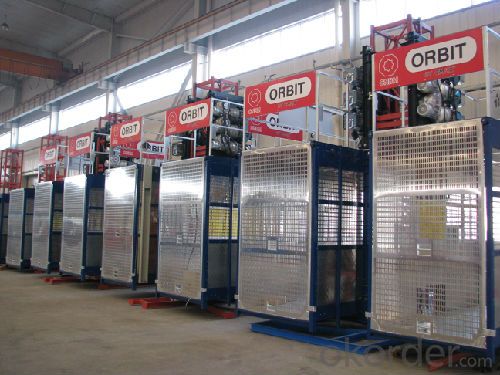
Elevator three-drive 650 frequency conversion (also known as external elevator, elevator for short) is widely applied to vertical lifting transportation of personnel and materials, is essential good transportation equipment in industrial or civil buildings, large bridges and vertical shafts, and can be applied in warehouses, high towers and other different occasions in a permanent or semi-permanent way. Compared with other lifting mechanisms, the product features stability, safety, reliability, no requirement on additional arrangement of machine room shaft ways, convenient assembly and disassembly, high carrying flexibility, etc., and particularly has obvious effects of relieving the labor intensity of constructors, accelerating project processes and improving working efficiency.
SC200/200 construction elevator is a high-performance product which is newly researched, designed and launched by our company. The elevator features reasonable design, novel structure, stable operation, complete and reliable safety devices and convenient installation and maintenance, and mainly has the following characteristics:
1. The transmission mechanism is driven by two motors, and pinions and racks are safe and stable due to uniform stress.
2. To ensure the safe operation of the elevator, an overload switch, a speed limit switch and other safety switches are arranged in the circuit; when overload, speed limit and other conditions occur in the operation process, the elevator automatically prevents accidents at once. Each door on cages is provided with a limit switch; when any door is opened abnormally, all the cages cannot start or immediately stop operating.
3. Each cage is provided with an anti-falling safety device which can extremely effectively prevent the cages from falling and ensure the safe and reliable operation of the elevator.
4. The electric control system of the elevator has a simple circuit, is convenient to control and maintain and is reliable. When operating normally, the elevator can be controlled to operate by a handle or button in a cage, can be stopped at any time at any position needing the stop, and can be controlled to stop automatically by upper and lower terminal limit switches at upper and lower terminal stations. When the upper and lower terminal limit switches fail to act, limit switches additionally arranged on the elevator can cut off the power supply in time to stop it in a braking mode.
5. The steel structure adopts a computer-aided design mode and is scientifically and strictly calculated to meet the requirements of reasonable structure, reliable intensity and light weight.
6. The elevator can be self-mounted or make standard knots detached by using a hanger rod on a cage. All the other parts can be conveniently mounted and dismounted, and components are easy to replace.
Attached: construction elevator model compilation method
The model of the elevator consists of class, group, type, feature, main parameter and deformation codes.
Notes: The main parameter code includes rated loading capacity codes of two cages, for example, only one main parameter code is marked on a single cage.
Example 1: SCD120
Representing a pinion-and-rack construction elevator with a single cage, the rated loading capacity of 1,200Kg and counterweight.
Example 2: SC200/200
Representing a pinion-and-rack construction elevator with double cages (each cage has the rated loading capacity of 2,000Kg) and no counterweight.
2、Technical performance parameters
Item | Unit | Parameter/specification | Notes | |
Rated loading capacity | kg | 2×2000 | Double-cage | |
Rated seating capacity |
| 2×18 | ||
Rated hoisting speed | m/min | 34.4 | i=16 | |
Maximum hoisting height | m | 150 | ||
Standard knot size | m | 0.80×0.80×1.508 | ||
Cage size | m | 3×1.5×2.5 | ||
Motor | Model | / | YZZ132L1-4 | Large force |
Power | kw | 13×2×2 | ||
Speed reducer | Center distance | mm | 140 | Large force |
Transmission ratio | / | 1:16 | ||
Protector | Form | / | Progressive | SAJ40-1.2 |
Rated action speed | m/s | 1.2 | Xingxiang | |
Calibrated action speed | m/s | 0.95 | ||
Braking torque | N.m | ≥3000 | ||
Braking distance | m | 0.15~1.40 | ||
Standard knot weight | kg | 145 | ||
Self weight of whole machine | kg | 12000 | 50m | |
- Q: Is it possible to use a building hoist for lifting delicate or fragile items?
- <p>A building hoist is typically designed for heavy construction materials and not recommended for lifting fragile objects. The vibrations and force exerted during lifting can damage delicate items. For fragile objects, specialized hoists or cranes with controlled movements and gentle handling capabilities are advised to ensure safety and prevent damage.</p>
- Q: This question asks whether a building hoist can be utilized in both indoor and outdoor environments for lifting objects.
- <p>Yes, a building hoist can be used both indoors and outdoors for lifting objects. These hoists are designed to handle heavy materials and are often used in construction settings. However, their use is subject to specific conditions and safety requirements. Outdoor use may require additional considerations such as weatherproofing and stability in various weather conditions, while indoor use must adhere to space limitations and structural integrity of the building. Always ensure that the hoist is suitable for the environment and that all safety protocols are followed to prevent accidents.</p>
- Q: Is it possible to operate a building hoist without undergoing professional training?
- <p>No, it is not advisable to use a building hoist without professional training. Operating a building hoist requires specific skills and knowledge to ensure safety and prevent accidents. Training programs teach the proper use of controls, safety procedures, and how to handle emergencies. Non-compliance with this can lead to severe injuries or fatalities. Always ensure you are adequately trained and certified before operating any hoisting equipment.</p>
- Q: How many guides are in the construction elevator
- 1 guide frame is 1508cm, the highest can be 400 meters
- Q: Can a building hoist be utilized to lift more than one object simultaneously?
- <p>Yes, a building hoist can be used to lift multiple objects at once, provided that the combined weight of the objects does not exceed the hoist's maximum load capacity. This is often done by securing all objects to a single lifting point or using a pallet or platform to hold the objects together. It's crucial to ensure that the hoist is rated for the total weight and that the objects are evenly distributed to maintain balance during lifting. Always follow safety guidelines and manufacturer's instructions to prevent accidents.</p>
- Q: This question asks whether a building hoist can be utilized in both indoor and outdoor environments.
- <p>A building hoist can indeed be used both indoors and outdoors, depending on the specific model and design. Outdoor hoists are typically built to withstand weather conditions and are more robust, while indoor hoists are designed for controlled environments. It's crucial to ensure that the hoist is suitable for the intended environment to maintain safety and functionality. Always follow the manufacturer's guidelines and safety regulations when using a building hoist in any setting.</p>
- Q: The construction elevator should have those procedures
- The construction elevator is short for construction. It is an important equipment in high-rise building construction, and construction site accident hazards easily, because it can cause many major accidents, injuries in the inspection should be listed as a key to check the content.
- Q: Is it possible to use a lifting device to lift objects that are heavier than its specified maximum load?
- <p>No, a lifting device should never be used to lift objects that exceed its rated load capacity. Doing so can lead to catastrophic failure of the device, potentially causing serious injury or death. Always adhere to the manufacturer's specifications to ensure safety and prevent accidents. Overloading a lifting device can result in structural damage, compromised safety mechanisms, and increased risk of collapse or dropping the load. It is crucial to respect the load limits to maintain the integrity and reliability of the lifting equipment.</p>
- Q: This question asks for measures to avoid accidents that may occur due to the misuse of a building hoist.
- <p>To prevent accidents caused by improper use of a building hoist, it's crucial to follow safety protocols strictly. Ensure all hoist operators are trained and certified. Regularly inspect and maintain the hoist equipment to check for any defects or wear. Never overload the hoist, and always secure the load properly. Implement clear communication procedures among workers, especially when the hoist is in operation. Set up barriers or warning signs to keep unauthorized personnel away from the hoist area. Finally, conduct regular safety drills to prepare for emergencies and reinforce safety practices among the workforce.</p>
- Q: This question asks about the time required to install a building hoist, a device used for lifting materials in construction.
- <p>The time it takes to install a building hoist can vary significantly based on factors such as the type and size of the hoist, the specific building requirements, and the experience of the installation team. On average, it can take anywhere from a few hours to a couple of days. For smaller hoists, installation might be completed within a day, while larger, more complex systems could take longer. It's important to note that safety checks and regulatory compliance verifications are also part of the process, which can add to the total installation time.</p>
Send your message to us
Elevator Three-Drive 650 Frequency Conversion
- Loading Port:
- Qingdao
- Payment Terms:
- TT or LC
- Min Order Qty:
- 1 set
- Supply Capability:
- 12 set/month
OKorder Service Pledge
OKorder Financial Service
Similar products
Hot products
Hot Searches
Related keywords

